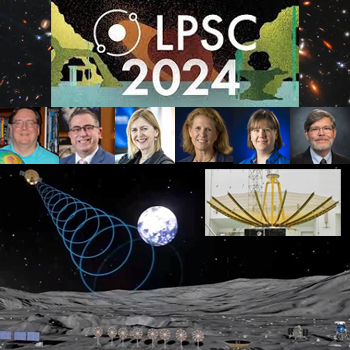Moon Matters: LPSC2024 in USA Being Held Prior to PRC Launch of Queqiao 2 Lunar Relay
|
MONDAY☆ Mar 11 — International Space Station, ~415-km LEO: Expedition 70 becomes 10-member crew with newly arrived SpaceX Crew-8 Matthew Dominick, Michael Barratt, Jeanette Epps, Alexander Grebenkin; preparing for Expedition 71 handover. ☆ Mar 11 — Tiangong Space Station, ~390-km LEO: Shenzhou 17 three-member crew continue to monitor solar panels on Tianhe core after 8-hour EVA repaired damage from space debris (14th spacewalk overall at TSS). Highlights… o NewSpace: mu Space of Thailand and Airbus to partner on smallsat development under new MoU; Reusable launch vehicle Callisto, built by CNES, DLR and JAXA, set to make 1st launch from Guiana NET 2025; NASA to develop Handheld Universal Lunar Camera for Artemis with Nikon of Japan based on mirrorless, full frame Z 9 model. ☆ Solar System: Juno measurements show Europa producing 12 kg of oxygen per second, contrary to previous estimates of 1,000+ kg/s; NASA and Roscosmos to address increasing air leak on ISS, Zvezda module to remain closed until April; Canada study finds 330-m diameter asteroid 99942 Apophis will safely pass ~31,600 km from Earth, within GEO ring. ☆ Galaxy: Caltech / Carnegie astronomer Stella Ocker hopes research interrupted by Voyager 1 anomaly can be continued by Interstellar Probe in 2030s; JWST Cycle 3 starting in July to include 253 General Observers programs over 5,500 hours including attempt to confirm first exomoon and TRAPPIST-1 b / -1 e studies. o Global: China Aerospace Science and Technology Corp to launch reusable 4 and 5-m diameter rockets NET 2025; India minister Singh projects $8B share of global space economy to increase 5x by 2040 as nation plans to award ~$3B in space-related defense contracts; Russia and China studying lunar nuclear power station concept with planned implementation in 2033-2035. ● USA: NASA to receive US$24.875B appropriation for 2024, $509M less than 2023 and $2.31B less than requested; Harvard & Smithsonian CfA building 750 devices to allow people with vision impairment to ‘hear’ upcoming eclipse on April 8 via Lightsound Project; VIPER build 80%+ complete at JSC clean room, landing on Astrobotic Griffin now in doubt per CLPS manager Joel Kearns. ● Hawai’i: IfA astronomers detect closest (160 ly) Tidal Disruption Event observed in visible spectrum via All-Sky Automated Survey for Supernovae and further characterized with ATLAS and Keck telescopes; Mary Beth Laychak of CFHT is 24th ATHENA Leadership Award recipient; NSF decision to cap funding of giant telescope-class projects to $1.6B will limit development of Giant Magellan Telescope or Thirty Meter Telescope. |
 |
● = Terrestrial and… o = International terrestrial events
☾ = Moon activity ★ = Space and… ☆ = International space / astro events in Hawaii Standard Time unless noted. Add 10 hours to obtain UT (‘Universal Time’). |
Weekly Planet Watch – Evening Planets: Jupiter (W), Uranus (W); Morning Planets: Venus (SE), Mars (SE).
March Storm Space Lobbying Blitz Kicks off in Washington DC
|
★ Mar 11 — SpaceX, Launch Falcon 9 / CRS SpX-30, SLC-40, Cape Canaveral SFS FL: SpaceX to launch CRS-30 Commercial Resupply Service mission to International Space Station. ● Mar 11 — NASA, Online / Washington DC: Submissions Due: Small Business Innovation Research & Small Business Technology Transfer (SBIR/STTR). ● Mar 11-13 — Space Frontier Foundation, Alliance for Space Development, National Space Society, Washington DC: March Storm 2024: Growth-Enabling Space Regulation. ● Mar 11-15 — Lunar and Planetary Institute (LPI), USRA, NASA, The Woodlands TX: 55th Lunar and Planetary Science Conference (LPSC) 2024. Ongoing… ☆ Sep 6, 2023 – NET Mar — X-Ray Imaging and Spectroscopy Mission (XRISM), ~550-km LEO: XRISM undergoing 6 month check out testing phase before start of science operations to study galactic plasma. o NET Feb – NET Apr — CNSA, Online / Beijing, China: Primary selection of international payloads for Chang’E-8 mission. ● Mar 8-16 — SXSW LLC, Austin TX: South by Southwest (SXSW 2024); conference, festival and exhibition. TUESDAY● Mar 12 — The Space Show, Online / Las Vegas NV: Dr. David Livingston hosts Fortuna Investments Justus Parmar on Investing in Space. ☆ Mar 12 — Apollo Asteroid 2015 FM34: Near-Earth Flyby (0.049 AU) WEDNESDAY● Mar 13 — Beyond Earth Institute, Online: Webinar: Sacred Skies: Respecting & Integrating Diverse Spiritual Perspectives in Space Policy; featuring Charlie Chafer (Celestis), Jason Batt (Beyond Earth), Karl Aspelund (Univ of Rhode Island), Alires Almon (WellPower). ☾ Mar 13 — Moon: 3.4° NNW of Jupiter, 14:00. ☆ Mar 13 — Jupiter and Uranus: At heliocentric conjunction, 16:00 |
THURSDAY
★ Mar 14 — SpaceX, Launch Starship (Booster 10 / Ship 28), Starbase, Boca Chica TX: Starship Flight Test 3 planned to reach 235 km apogee before powered descent in Indian Ocean.
● Mar 14-18 — Academy for the Relentless Exploration of Space (ARES Learning), Various Locations NM: Astrogeology for Educators.
☾ Mar 14 — Moon: 3.2° NNW of Uranus, 00:00; 0.50° ESE of Pleiades, 19:00.
☆ Mar 14 — Aten Asteroid 2020 FU: Near-Earth Flyby (0.038 AU)
FRIDAY
● Mar 15 — Colorado School of Mines, Golden CO: Abstracts Due: 24th Meeting: Space Resources Roundtable (SRR 2024); being held June 3-7.
☆ Mar 15 — Apollo Asteroid 2024 EQ: Near-Earth Flyby (0.017 AU)
SATURDAY
o Mar 16 — Gemini South, NOIRLab, Mt. Cerro Tololo, Chile: Public Visits to Gemini Observatory atop Mt. Cerro Tololo; 42 people per tour.
☾ Mar 16 — Moon: At first quarter, 18:11.
☆ Mar 16 — Apollo Asteroid 2024 EQ: Near-Earth Flyby (0.017 AU)
SUNDAY
☾ Mar 17 — Moon: 4.2° N of M35 cluster, 05:00.
☆ Mar 17 — Mercury: At perihelion; 0.3075 AU from the Sun, 07:00.
☆ Mar 17 — Neptune: At conjunction with Sun, 30.897 AU from Earth.

